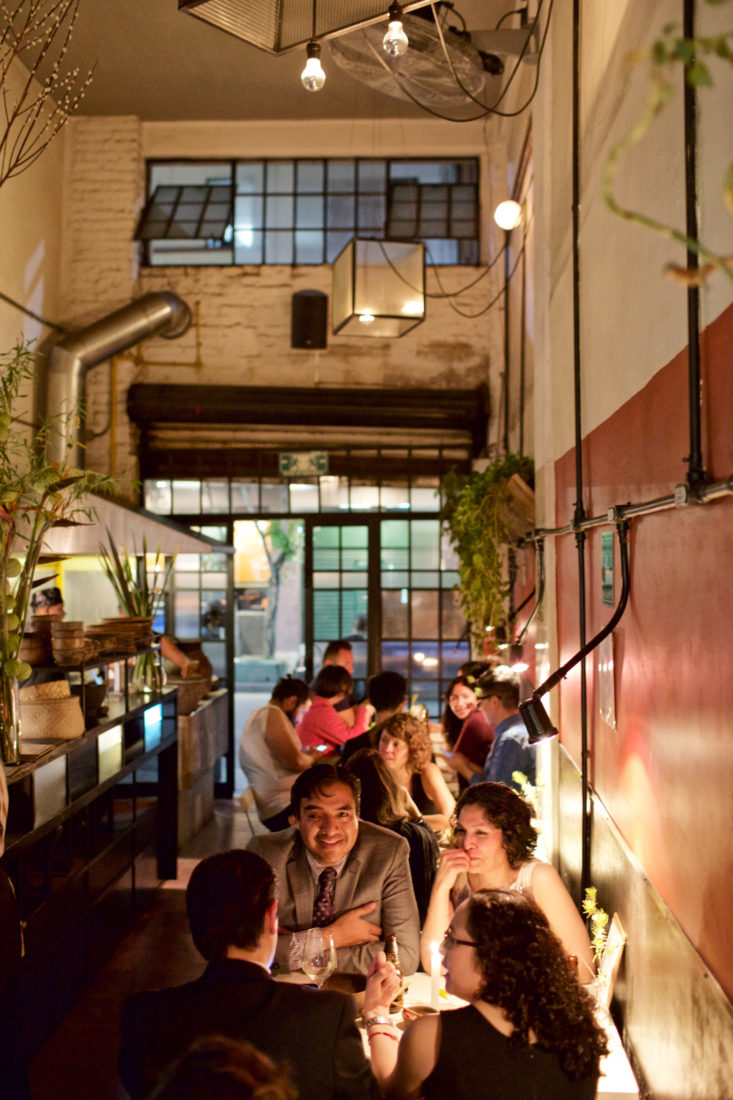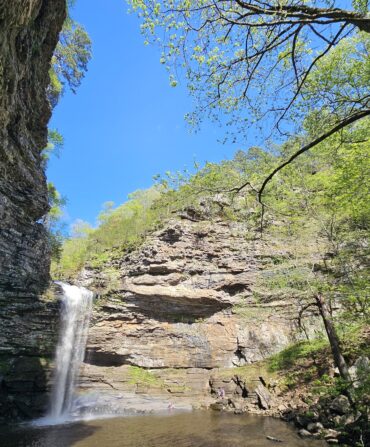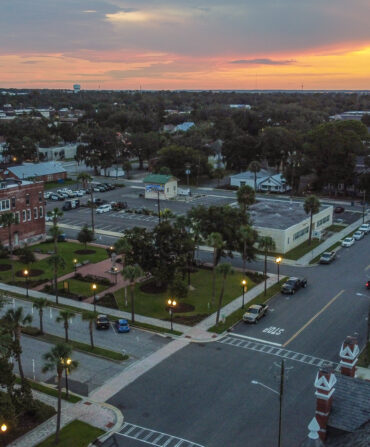Where to Eat + Drink
Abarrotes Delirio
Roma
Craving gourmet but need a quick bite between itinerary stops? Chef Mónica Patiño’s small grocery serves up sublime salads, quiches, empanadas, and desserts, along with made-in-Mexico packaged delicacies. Local tip: Improve the restaurant’s exceptional flourless chocolate cake by topping it with a dollop of dense, spicy morita chile salsa from the sandwich condiments. —abarrotes.delirio.mx/restaurante
Bósforo
Centro
At this small, hip, but decidedly untrendy mezcaleria, most of the mezcals come straight from rural palenques. Taste spirits made from a range of agave plants, especially less common varieties such as tepeztate, one of the kings of wild agaves, which matures for twenty to thirty years before it’s ready for harvest. When Bósforo bartenders spill mezcal on the bar, rather than reach for a towel, they fight fire with fire by lighting it with a candle and letting the liquid burn off.
Contramar
Roma
This seafood temple draws quite the lunch crowd—politicians and telenovela stars fill the packed dining room—so get here early. Start with Contramar’s famed tuna tostada, a house specialty combining sashimi-grade fish with the crunch of toasted corn tortillas and the burn of chipotle mayo, all topped with fried onions and avocado. —contramar.com.mx

El Parnita
Roma
Even amid the city’s booming dining scene, it’s hard to beat this friendly, bustling spot for tacos, tortas, and other Mexican comfort food. The kitchen’s unadorned offerings brim with confidence. The Viajero, for example, is a handmade corn tortilla filled simply with outstanding spice-braised pulled pork. —elparnita.com
Eno
Roma
Enrique Olvera became Mexico’s most famous chef through a brazen but earnest reinvention of traditional fare, a process he has called “screwing with Mexican grandma recipes.” He’s best known for Pujol in Polanco, but Olvera’s talents are also on display at this breakfast and lunch spot. The sandwiches (one stacks rib-braised beef, pickled red onion, guacamole, and ancho chile on a baguette), salads (cured nopal cactus, pinto beans, avocado, and tomato), and Mexican favorites (squash-blossom corn-masa quesadillas with the pungent herb epazote) are a revelation. —eno.com.mx
Lalo
Roma
In 2012, chef Eduardo “Lalo” García hit the stratosphere when he opened the French-inspired Máximo Bistrot. Lalo, one block away, is his fun, casual eatery, especially beloved for its brunch. Out too late last night? Go for the chilaquiles, a comforting mound of fried tortilla strips, queso cotija, avocado, and a fried egg in salsa verde. If the food doesn’t lift your spirits, the restaurant’s colorful, full-length mural painted by a notorious Belgian expat called Bue the Warrior will. —eat-lalo.com

Photo: Jody Horton
The refreshing Mr. Pink cocktail at Limantour, in the Roma neighborhood.
Limantour
Roma
One of the city’s finest cocktail bars, this standout is named (with a wink) for the government official who, in the nineteenth century, levied Mexico’s first liquor tax. Try the Mr. Pink, a silky concoction of gin, grapefruit juice, and basil, garnished with rosemary. —limantour.tv
Rosetta
Roma
The highly regarded Mexican chef Elena Reygadas wows diners with her paean to Italian cuisine in a lovingly restored townhouse. Rather than flash, Rosetta delivers homemade pastas with hyperfresh regional ingredients, such as the tagliatelle with Italian sausage and chiles de árbol, small fiery Mexican peppers. For excellent coffees, breads, and other pastries, the chef’s Panadería Rosetta sits across the street. —rosetta.com.mx

Photo: Jody Horton
Inside the Palacio de Correos.
What to See + Do
Chapultepec Park
Reforma Corridor
Who knew the Western Hemisphere’s largest urban park was in Mexico City? The expansive green space, whose name means “grasshopper hill” in Nahuatl, is divided into three sections and boasts ten museums, including the Museo Tamayo, which showcases a broad collection of Mexican contemporary art. Take in panoramic views of the city from Chapultepec Castle, an ornate nineteenth-century palace perched atop a hill that was once a sacred Aztec site.
Museo de Arte Popular
Centro
Housed in a beautifully restored art deco building, this folk-art collection includes Oaxacan black pottery, intricate lacquerware, and vivid textiles hand embroidered by the indigenous Otomi people. Inspired by something you see? The excellent gift shop carries pieces by some of the country’s best living folk artists. —map.cdmx.gob.mx
Museo Frida Kahlo
Coyoacán
Mexico’s most famous artist lived in this home with her husband, Diego Rivera, and died here in 1954, at age forty-seven. Along with plenty of art by the couple and friends such as Paul Klee, the ten-room cobalt-blue house is filled with curiosities. Above Kahlo’s bed is the mirror she used for her renowned self-portraits, while in a nearby corner the ashes of the enigmatic artist rest in an urn. Arrive early to beat the crowds, and leave time for the courtyard garden, where the pair’s pre-Hispanic artifacts are displayed. —museofridakahlo.org.mx
Plaza de Santo Domingo
Centro
The dying art of letterpress printing is alive and well beneath this plaza’s historic colonnade. Listen for the mechanical clack-clack of hand-cranked presses coming from the stationery-festooned kiosks. City residents come here for wedding invitations, holiday cards, and the like. Commission a stack of cards—pressed while you wait—and you’ll have a special thank-you to send the host of your next dinner party.

Photo: Jody Horton
Taking a break on the rooftop of Barrio Alameda in the Centro Histórico.
Where to Shop
Carla Fernández
Centro
Like chef Enrique Olvera, fashion designer Carla Fernández celebrates Mexican traditions by blowing them up. Deeply familiar with native design, Fernández reinterprets indigenous garment forms and textile techniques. Check out her funky wooden bracelets made from the rings of molinillos, traditional Mexican hot-chocolate whisks. —carlafernandez.com/en
Onora
Reforma Corridor
Originally from New York, Onora’s co-owner Maggie Galton works closely with artisans (mostly women) from different regions of Mexico to produce a gorgeous collection of textiles and home goods such as geometric throw pillows hand woven in Chiapas. The designs are especially noteworthy for their thoughtful blend of tradition and innovation. —onoracasa.com
Remigio mestas
Centro
On the second floor of the Downtown Mexico hotel, this small shop brims with stacks (and stacks) of Oaxacan textiles made from natural dyes. If you’re shopping for a rebozo—the colorful, versatile Mexican shawl—this is the place. —theshops.mx
Taller Experimental de Cerámica
Coyoacán
This pioneering pottery studio (and shop), founded in 1964 by Alberto Díaz de Cossío and now run by his daughter Adriana, is nestled beneath a three-hundred-year-old pepper tree and supplies tableware for many of Mexico City’s top restaurants. —ceramicadiazdecossio.com.mx
Taxonomía
Reforma Corridor
Much more than a typical gift shop, this stunning boutique is the retail manifestation of a seventy-two-member artist collective bent on raising the bar of Mexican design for housewares, clothing, and everything in between. The handmade felt rugs by Déjate Querer are a marvel of color and intricate patterns. Most take their inspiration from nature—butterflies, cacti—and though they might be floor coverings, you’ll be tempted to display these works of art on a wall. —facebook.com/taxonomiamx

Photo: Jody Horton
Under the Sun
A nice spot by the Downtown Mexico hotel’s rooftop pool.
Where to Stay
Downtown Mexico
Centro
Opened in 2012, this seventeen-room hotel with a rooftop pool is housed in a four-hundred-year-old palace two blocks from the Zócalo, the city’s central plaza and a popular gathering place for locals. The hotel also contains two excellent restaurants—Azul Histórico and Puntarena—and many shops. —downtownmexico.com
Hotel Carlota
Reforma Corridor
This sleek boutique hotel, which opened in 2015 off Paseo de la Reforma, has a following among design-focused travelers. Many of its chairs, rugs, textiles, and other room furnishings are made by well-known Mexican artisans and available for purchase. The chic lobby bar and poolside restaurant open to a lovely central courtyard—the perfect setting to start your day. —hotelcarlota.com








